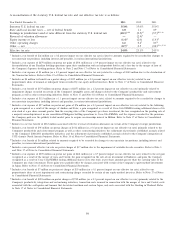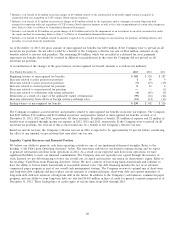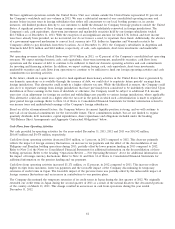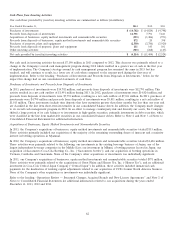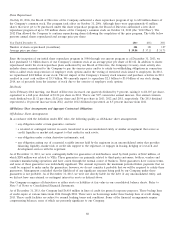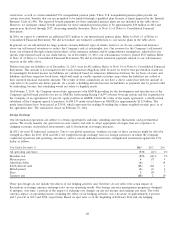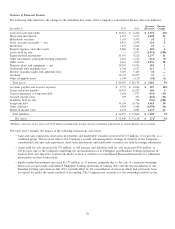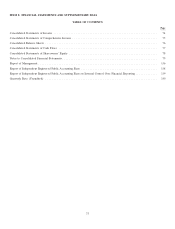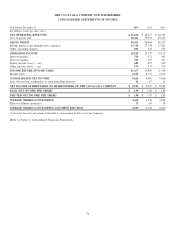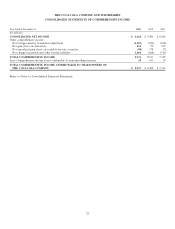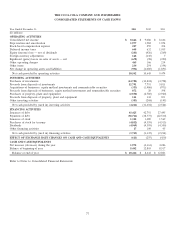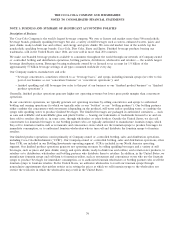Coca Cola 2013 Annual Report Download - page 71
Download and view the complete annual report
Please find page 71 of the 2013 Coca Cola annual report below. You can navigate through the pages in the report by either clicking on the pages listed below, or by using the keyword search tool below to find specific information within the annual report.coverage in place, the Company expects currencies to have a 10 percent negative impact on operating income for the first quarter
of 2014 and a 7 percent negative impact on operating income for the full year of 2014.
Foreign currency exchange gains and losses are primarily the result of the remeasurement of monetary assets and liabilities from
certain currencies into functional currencies. The effects of the remeasurement of these assets and liabilities are partially offset by
the impact of our economic hedging program for certain exposures on our consolidated balance sheets. Refer to Note 5 of Notes
to Consolidated Financial Statements. Foreign currency exchange gains and losses are included as a component of other income
(loss) — net in our consolidated financial statements. Refer to the heading ‘‘Operations Review — Other Income (Loss) — Net’’
above. The Company recorded foreign currency exchange losses of $162 million, $2 million and $73 million in 2013, 2012 and
2011, respectively.
Hyperinflationary Economies
Our Company conducts business in more than 200 countries, some of which have been deemed to be hyperinflationary economies
due to excessively high inflation rates in recent years. These economies create financial exposure for the Company.
A hyperinflationary economy is one that has cumulative inflation of 100 percent or more over a three-year period. Effective
January 1, 2010, Venezuela was determined to be a hyperinflationary economy. In accordance with hyperinflationary accounting
under accounting principles generally accepted in the United States, our local subsidiary was required to use the U.S. dollar as its
functional currency.
During February 2013, the Venezuelan government devalued its currency to an official rate of exchange (‘‘official rate’’) of
6.3 bolivars per U.S. dollar. The Company remeasured the net assets of our local subsidiary and recognized a related loss of
$140 million from remeasurement in the line item other income (loss) — net in our consolidated statement of income.
The Company will continue to use the official rate to remeasure the net assets of our Venezuelan subsidiary. In December 2013,
the Venezuelan government devalued the currency for foreign tourists to 11.3 bolivars per U.S. dollar. While this rate is not
applicable to the Company, it may indicate that another official currency devaluation that would impact companies doing business
in the country could occur. If the official rate devalues further, or if we are able to access currency at different rates that are
reasonable to the Company, it would result in our Company recognizing additional foreign currency exchange gains or losses in
our consolidated financial statements. As of December 31, 2013, our Venezuelan subsidiary held monetary assets of $426 million
and monetary liabilities of $45 million.
In addition to the foreign currency exchange exposure related to our Venezuelan subsidiary’s net assets, we also sell concentrate
to our bottling partner in Venezuela from outside the country. These sales are denominated in U.S. dollars. If a government-
approved exchange rate mechanism for future concentrate sales to our bottling partner in Venezuela is not available, the amount
of receivables related to these sales will continue to increase. The carrying value of these receivables was $267 million and
$109 million as of December 31, 2013 and 2012, respectively. In addition, we have certain U.S. dollar denominated intangible
assets associated with products sold in Venezuela. If the bolivar further devalues, it could result in the impairment of these
intangible assets. As of December 31, 2013, intangible assets associated with products sold in Venezuela had a carrying value of
$107 million.
The Company will continue to manage its foreign currency exposure to mitigate, over time, a portion of the impact of exchange
rate changes on net income and earnings per share.
Impact of Inflation and Changing Prices
Inflation affects the way we operate in many markets around the world. In general, we believe that, over time, we are able to
increase prices to counteract the majority of the inflationary effects of increasing costs and to generate sufficient cash flows to
maintain our productive capability.
69


